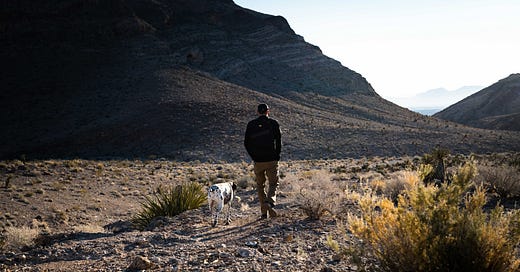Walk, Duh
Humankind's simplest activity might be its best for your recovery, health, and mindset.
Post summary
On Monday, we covered three low-effort, high-impact recovery practices.
Today, we’re covering what I think is arguably the best recovery practice beyond sleep and nutrition: Walking. But walking has far more benefits than that …
We overlook walking, but the (slight) effort of walking will help you recover quicker, improve your baseline endurance, and free your mind to think better.
We’ll cover all the upsides of walking and the specifics of how I program walking into my overall fitness routine.
Housekeeping
This post, like all Wednesday and Friday Two Percent posts and their audio editions, is for Members of Two Percent.
Have fun, don’t die, join us: Become a Member of Two Percent:
Thanks to our partners, who make the best products in their categories.
Maui Nui Venison: Provider of the world’s healthiest meat (the research, linked here, is wild). My go-to: Organ blend 90-10 and pepper venison jerky sticks.
GORUCK: Maker of the best rucking gear (not stuff). Check out the Rucker 4.0.
Momentous Nutrition: The company that made me feel good about supplements again. My picks: Essential Plant Protein + Multivitamin.
Discount code EASTER for all brands.
Audio/podcast version
The post
On Monday, we discussed how recovery doesn’t have to be as time- and labor-intensive as we think. We featured five powerful, no-effort recovery methods.
Then there is walking. Although it requires a bit more effort, I firmly believe walking is the best method to recover, build a foundation of health, and strengthen your mindset.
I realized the power of walking for recovery about a decade ago.
I had a friend who was an elite outdoor athlete—a legend in the mountains who’d reached the pinnacle of his sport.
As you might imagine, he was always fit. Like, exceptionally fit.
But suddenly, after years of remaining at a high fitness level, he became even fitter.
His 2,000-meter row time dropped. His strength improved. He could produce more power deeper into long, hard workouts.
And this was all very perplexing. This guy’s training hadn’t changed. He was eating the same. Exercising and sleeping the same. He hadn’t started taking some new supplement.
After peeling back all the layers, there was only one change in his life: He’d gotten a dog and was walking the dog for at least 30 minutes a day.
Those walks helped him recover between his hard workouts and added to his overall endurance base, allowing him to do more.
The walks made him better in the gym. They made him better in the mountains. And, to top it all off, he said the walks had become the most relaxing thing he did—a sort of moving meditation.
That’s the power of walking—which you should do. Ideally outside. Daily.
The big sales pitch is that walking will make you fitter. But walking has this funny effect: You start walking for the fitness benefits, but you keep walking for all of the other benefits walking delivers.
This post is a quick primer on why you should walk more. You’ll learn:
Why humans are built to walk.
The body benefits of walking.
The brain benefits of walking.
How I program walking into my overall health and fitness routine (it’s a cornerstone).
Why humans are built to walk
Section summary: Humans are generally unathletic—but we are exceedingly good at walking long distances. This allowed us to take over the world.
If you read The Comfort Crisis, you know that humans are “athletically pathetic,” as the wise Harvard anthropologist Dan Lieberman told me.
Compared to other mammals, we’re not fast. We’re not that strong. We suck at climbing. We’re not good jumpers and jukers (don’t believe me? Try chasing down a dog).
But about six million years ago, some magic began happening that allowed us to take over the world and become the apex species.
We started to walk.
Back then, our ancestors were much more ape-like than we are now (we hadn’t broken off into “humans,” the genus “homo” yet). But then …
The Earth began cooling, shrinking the jungles where our ancestors lived.
The shrinking, colder jungles gave our ancestors less fruit, which they subsisted on.
Our ancestors were forced to cover greater distances to find fruit to survive.
Natural selection did its thing: The apes that had unique bodily quirks that allowed them to cover more ground efficiently and reach higher into trees to get more fruit survived and passed on their DNA.
The beautiful feedback cycle continued: Our ancestors developed features that improved their survival. They began to stand upright and walk on two feet instead of moving via the four-limbed “knuckling walking” like most other apes.
They developed arches in their feet, large knee joints, knees angled under their hips, a large hip joint that faces sideways, a tall narrow waist, a long spine, and much more.
These adaptations were all so we could walk farther with less effort—and walking also freed our hands so we could carry food, kids, and tools along the way.
Research suggests our homo sapiens ancestors walked anywhere from 6 to 15 miles a day. For comparison, our closest primate cousins only cover one or two miles daily. Walking and carrying are our killer apps.
Those Harvard researchers told me something I’ll never forget. It shifted my thinking around exercise.
They said that for health, it probably makes sense to lean into what we humans are best at: covering ground on foot. Mostly at a walk. Often while carrying weight. Sometimes at a run.
Which brings us to our next point …
Walk for your body
Section summary: Walking is powerful for recovery and leads to unique physiological changes that significantly improve health. The research is *wild.*
I’ve found walking to be the best thing I can do to recover.




